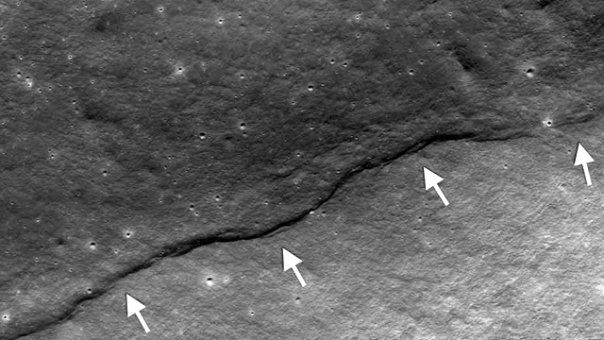
The fact that the moon's gravitational pull affects ocean tides is well-known. However, what scientists did not know is that the Earth's gravity has a similar tug on the satellite. The only difference is that the effects are much worse since the pull results in exacerbating and changing the direction of the cracks on the lunar surface.

Called lobate scarps, the faults are the result of the cooling and contraction of the hot interior of the moon. As portions of the liquid outer core solidify the volume decreases, causing the moon to "shrink" and its solid outer crust to buckle. The cliff-like formations are fairly common and have also been found on Mercury and Mars. However, when scientists examined the over 3,000 lobate scarp images transmitted by NASA's Reconnaissance Orbiter (LRO), that has been orbiting the satellite since 2009, they noticed something unusual.
Instead of being randomly distributed across the moon's surface, similar to how they are on other planets these had a pattern. This led the scientists to wonder if they were being influenced by something else in addition to the regular global contraction of the moon. After examining the patterns closely and running some simulation models, the team led by Smithsonian planetary scientist Thomas Watters confirmed that the "something" is Earth's gravitational pull.

It works the same way as the moon's gravity works on our tides. The only difference is that since the moon does not have water, it is the crust that rises and falls, resulting in stresses or faults. Watters says that when these smaller faults superimpose on the larger ones caused by the cooling interior, the combined stresses produce cracks that form distinct patterns oriented in the direction where the Earth's gravitational pull is the strongest. What's worse is that our gravity may even be causing "moonquakes", something the researchers still need to verify using equipment similar to that used to measure earthquakes.

While this close "relationship" that was reported in the October issue of Geology is causing a lot of excitement among researchers, it is not as thrilling for the moon whose surface continues to get pulled, rearranged, and probably even jolted, on a daily basis! And for those that are worried about our moon 'tearing' into pieces, keep in mind that while we may have just discovered it, this tug of war has been going on for billions of years. As far as we can tell, both earth and its satellite are doing fine!
Resources: dailymail.co,uk, zme.com, newsdesk.si, nasa.gov, kudzuacres.com